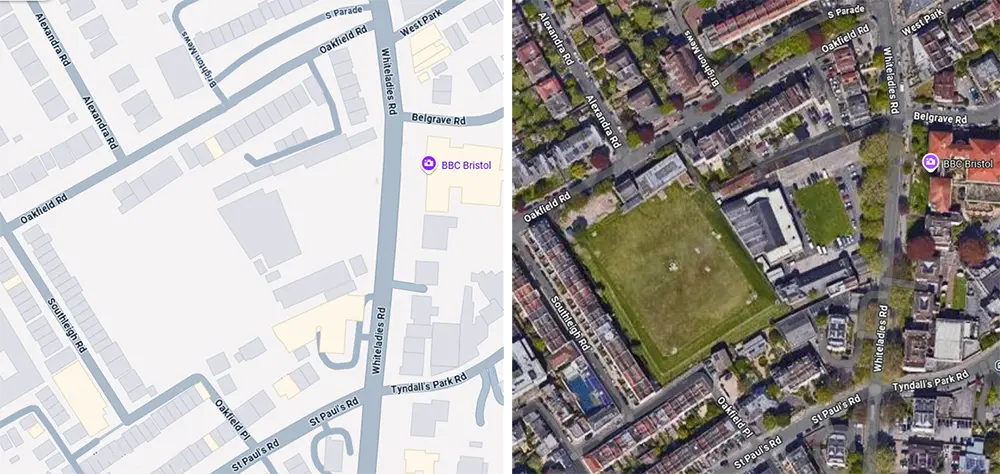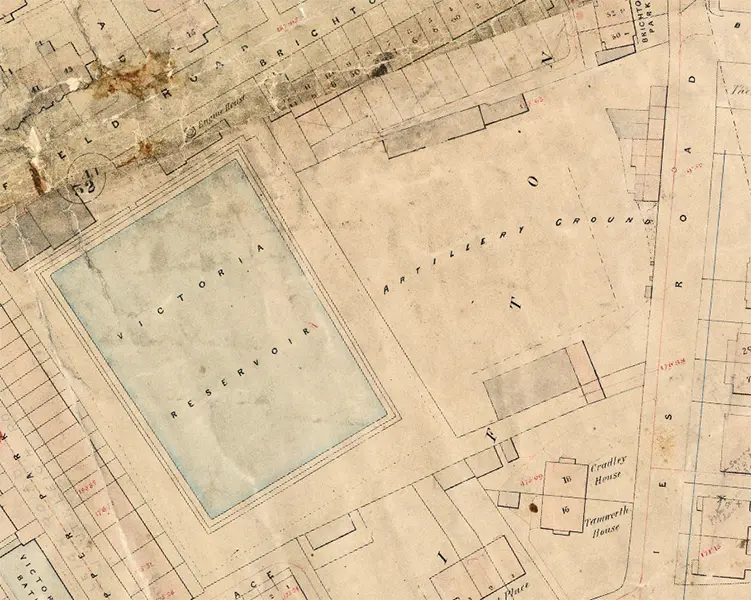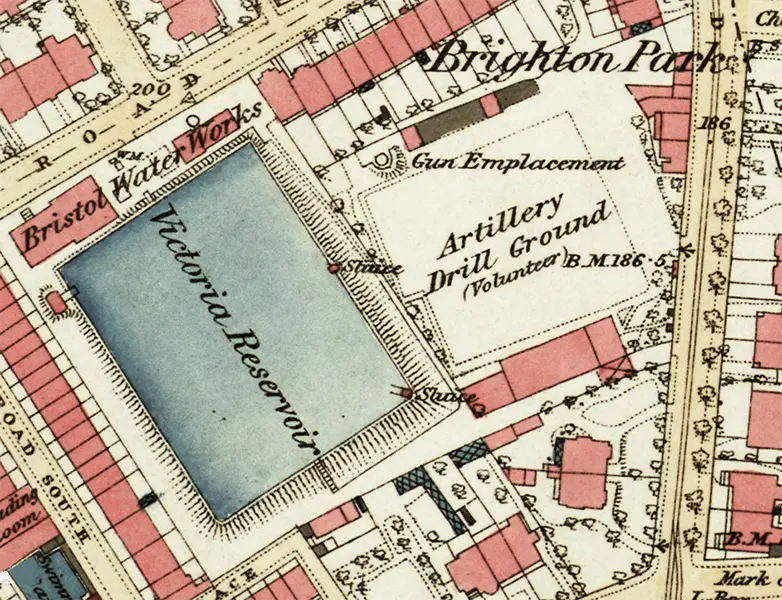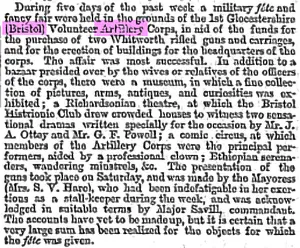The Artillery Ground
A History
Introduction
On the 22 November 1859, the Gloucestershire Volunteer Artillery (GVA) was formed, making it's headquarters at the Artillery Ground, Whiteladies Rd. Clifton, Bristol. The unit started with five batteries with a sixth added later. The GVA were tasked with the defence of the Bristol Channel and the ports of Bristol and Gloucester and were fully paid for and organised by the City of Bristol, it was not part of the War Office responsibilities.
In May 1860, the newly formed Gloucestershire Artillery Volunteers were fortunately able to secure a long lease from the Society of Merchant Venturers of the existing parade ground on Whiteladies Road, Clifton, Bristol, and an appeal was made to the public for funds for the construction of an armoury, sheds and stores at a cost of £1,100, while a Drill Hall was added in 1895, at a further cost of £1,200. They received four 18 pounder smooth bore guns from the War Office which were installed on the old Avon Battery site at Avonmouth on 21 July 1860, and used for firing practice at a sea target.
In March 1880, the Gloucestershire Volunteer Artillery had become the 1st Gloucestershire Artillery Volunteers (Gloucester and Somerset). Starting in 1906, the Secretary of State for War Richard Haldane's Reforms were designed to better prepare the armed forces for future wars and involved a reorganization of the regular, volunteer and militia forces. The volunteer forces were reformed into a Territorial Force (TF) which had its own organisation and was tasked with the defence of the UK homeland.
The GVA was transferred from the Royal Garrison Artillery (RGA) to become part of the Royal Field Artillery (RFA). In 1967, the Territorial Army forces were halved under a review produced by Generals John Hacket and Michael Carver. Thus 883 Battery became A (GVA) Squadron, Royal Gloucestershire Hussars (V) and served as part of the TAVR 3 force, with a responsibility for Home Defense, until 1969 when it was disbanded.
Although officially disbanded, the Bristol Gunners refused to relinquish their right to parade at the Artillery Ground and formed the Bristol Royal Artillery Club, sometimes known as the "Old Stiffs Mess," which met every Friday night for "Bar Drills." It was in 1971 that the BRA Club was responsible for providing the nucleus of the newly formed 266th (Gloucestershire Volunteer Artillery) Observation Post Battery RA (V).
In 1971, 266 (Gloucestershire Volunteer Artillery) Observation Post Battery was formed using the Bristol Royal Artillery Club as a nucleus as an independent Observation Post unit as a reinforcement unit for BAOR supplying observation post teams. The battery had a four gun troop of 25pdr field guns. In time of war the battery would provide 18 Observation Post Parties to regular army units.
In 1992, it was re-roled as a field battery operating 105mm Light Guns, supporting 7 Para RHA, and trained troops were entitled to wear the maroon beret from 1994.
In 1999, 266 joined 289 Battery who were based in London and became part of 100th (Yeomanry) Regiment Royal Artillery with the battery supporting both 7 Para RHA and 29 Commando Regiment. The Plymouth based 289 Commando Troop formed part of the battery.
On 31 March 2009, The Lord Mayor of Bristol, Christopher Davies, accorded 266 (Gloucestershire Volunteer Artillery) Battery, Royal Artillery (Volunteers) the honour of the "Freedom of the City."
Under Army 2020 plans 100th Regiment RA operations were suspended and in 2013, 266 Battery re-roled to operate Desert Hawk 3 Mini Unmanned Air Systems (M-UAS) and was re-designated to 104 Regiment Royal Artillery.
In 2017, 266 Battery re-roled back to L118 Light Gun and currently operates as part of 104 Regiment Royal Artillery who are part of 1st Deep Reconnaissance Strike Brigade Combat Team, providing gun sections, fire support teams (FSTs), and Command Post (CP) personnel.
Throughout this time, in 2024 it has been165 years, the Artillery Ground has been the Bristol Gunners home.
Location
The Artillery Ground is located on Whiteladies Road, Clifton, Bristol in the area known as Brighton Park, and in 2024 has been home to Bristol Gunners for 165 years. It is opposite the BBC Bristol building and bounded by Whiteladies Road, Oakfield Road to the north, St, Paul's Road to the south and the covered Victoria Reservoir to the west.

The Artillery Ground, Bristol
Images: Google Maps
Area History
According to the maps on the Bristol City website, although there were a few buildings on the site of the Artillery Ground on the Whiteladies Road side since before 1828, the site was largely undeveloped. This changed between 1840 and 1855. The original open Victoria Reservoir was built in 1848, then rebuilt and covered in 1914. Houses and other buildings were erected along Whiteladies Road and Brighton Park (now Oakfield Road) in 1849.
Park Tavern was built on the Whiteladies Road side of the area and the landlords for that were:
1834 to 1853 - James Embley
1854 to 1856 - Mrs. H. Embley
1857 to 1858 - William George Hopkins
1859 - Elizabeth Hopkins
1860 to 1868 - John Down
Although the entire area was looking almost identical to today by 1874, the buildings on the Whiteladies Road side of the site were still there in the 1880s, but had all gone by 1900.
The first time the Artillery Ground appears on the maps held on the maps on the Bristol City website is the George C. Ashmead map of 1874, some 15 years after the Gloucestershire Volunteer Artillery (GVA) was formed and housed there.

The Artillery Ground, Bristol, Ashmead map of 1874
Image: Bristol City website
In the above map the buildings on the east (Whiteladies Road, side of the site are still there, but two new buildings to the south and north have appeared, In the 1890s and 90s the south building were for vehices and the puff range and the north building were the gun sheds and rifle range. At the time this map was made the south building was the main drill hall.
By the 1880s, a gun emplacement had been built to the west of the north buildings of the site. A new Drill Hall to the west of the site was built in 1936.

The Artillery Ground, Bristol, map of 1880s
Image: Bristol City website
Fund Raising
The new original buildings had to be paid for and to raise money for the Corps so that it could discharge the debt that the unit had incurred to build the drill hall and the cost of two Whitworth 12pdr Field guns, the unit laid on various events.
Sewing Bees (a gathering of ladies who would sell their sewing) were held at the Artillery Ground to raise funds.
Dinners and dances were also organised by the unit, some members would donate funds or give a prize for a raffle, one such donation can be seen today in the officers mess which is the mahogany dining table, it was donated by a Gunner who was a partner in the furniture company of Phillips and Co., Union St, Bristol which was at the bottom of Union street on the junction with Nelson Street.
The members of the unit would entertain at dinners and dances, singing and Indian club swinging, many functions like the annual Christmas party were held in The Victoria Rooms and the Crown and Dove, Rupert street. Most large public houses (pubs) would have a upstairs room which was hired for such functions.
It is not known where this newspaper clipping is from, but probably from 1861:
 During five days of the past week a military fete and fancy fair were held in the grounds of the 1st Gloucestershire (Bristol) Volunteer Artillery Corps, in aid of the funds for the purchase of two Whitworth rifled guns and carriages, and for the erection of buildings for the headquarters of the corps. The affair was most successful. In addition to a bazaar presided over by the wives or relatives of the officers of the corps, there were a museum, in which a fine collection of pictures, arms, antiques, and curiosities was exhibited; a Richardsonian theater, at which the Bristol Histrionic Club draw crowded houses to witness two sensational dramas written specially for the occasion by Mr. J. A. Ottay and Mr. G. F. Powell; a comic circus at which members of the Artillery Corps were the principle performers, aided by a professional clown; Ethiopian serenaders, wandering minstrels, &o. The presentation of the guns took place on Saturday, and was made by the Mayoress (Mrs. S. V. Hare), who had been indefatigable in her exertions as a stall-keeper during the week; and was acknowledged in suitable terms by Major Savill, commandant. The account has yet to be made up, but it is certain that a very large sum has been realized for the objects for which the fete was given.
During five days of the past week a military fete and fancy fair were held in the grounds of the 1st Gloucestershire (Bristol) Volunteer Artillery Corps, in aid of the funds for the purchase of two Whitworth rifled guns and carriages, and for the erection of buildings for the headquarters of the corps. The affair was most successful. In addition to a bazaar presided over by the wives or relatives of the officers of the corps, there were a museum, in which a fine collection of pictures, arms, antiques, and curiosities was exhibited; a Richardsonian theater, at which the Bristol Histrionic Club draw crowded houses to witness two sensational dramas written specially for the occasion by Mr. J. A. Ottay and Mr. G. F. Powell; a comic circus at which members of the Artillery Corps were the principle performers, aided by a professional clown; Ethiopian serenaders, wandering minstrels, &o. The presentation of the guns took place on Saturday, and was made by the Mayoress (Mrs. S. V. Hare), who had been indefatigable in her exertions as a stall-keeper during the week; and was acknowledged in suitable terms by Major Savill, commandant. The account has yet to be made up, but it is certain that a very large sum has been realized for the objects for which the fete was given.
Uses Today
The Drill Hall, its classrooms and other meeting spaces are today home to 266 Bty GVA (V), as well as 1 Troop 100 Fld Sqrdn Monmouthshire Royal Engineers, A Company 6 Rifles, and Bristol University Officer Training Corps (BUOTC) and a Military Preparation Academy but are also used for a variety of uses by different organisations such as the Avon Fire & Rescue Service, the Clifton Lawn Tennis Club, the Grenadier Guards Association, the Somerset & Cornwall Light Infantry Association, concerts, student meetings, and weddings.
The Wessex Reserve Forces’ and Cadets’ Association site lists some of the facilities the buildings offer.
Sources and Resources
Derek Driscoll's original pages
Fund raising for the H.Q. Building and Drill Hall
Other Sources
Arrowsmith's dictionary of Bristol, 1884 - Internet Archive
Bristol’s Lost Pubs (Clifton)
Managing risk at Victoria Service Reservoir - The British Dam Society
Maps Bristol Government
The Whiteladies Road 25-Pounder - Eugene Byrne
Victoria Reservoir, Oakfield Road - One-Mile Matt
Wessex Reserve Forces’ and Cadets’ Association
